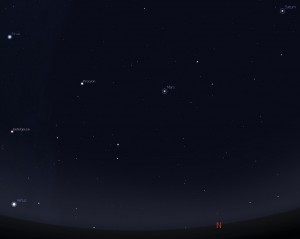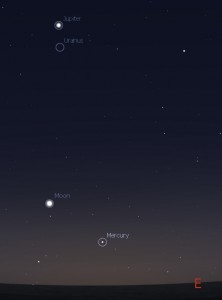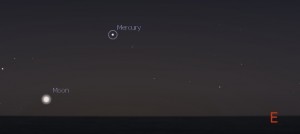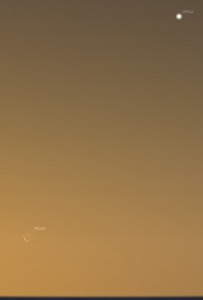These notes are intended to provide a casual skywatcher or someone already into amateur astronomy living in Brisbane, the Gold Coast and the Sunshine Coast with a short summary of what is happening in the night sky this week. Most of the information and finder charts will also be useful for observers elsewhere in Eastern Australia.
Keep in mind that you can follow this website automatically using Twitter and the sites RSS Feed.
Predictable Sky Events
All week
The planets Venus, Mars and Saturn are easily visible to the unaided eye in the evening sky all week. The below chart is for Sunday 9 May 2010 for approximately 6.30pm AEST but is useful for the whole week.
Sunday 9 May 2010
Crescent Moon located above and to the left of Jupiter. Morning pre-dawn sky.
Monday 10 May 2010
Crescent Moon located below and to the left of Jupiter. Morning pre-dawn sky.
Tuesday 11 May 2010
Mercury appears stationary in the (morning dawn) sky.
If you are out walking early Tuesday morning in the Brisbane CBD, look above the North North East horizon at 5.41am for a bright (-7) Iridium flare. The flare will only last 10 – 15 seconds but will be worth looking for.
Wednesday 12 May 2010
If you are an early morning riser, don’t forget to look for the sky show above the Eastern horizon. Jupiter, a slim crescent Moon and Mercury will form a triangle in the dawn sky. From South East Queensland, this will be visible about 5.30am AEST.
Mercury at aphelion (at its most distant point in its orbit from the Sun).
If you are out walking early Wednesday evening on Mermaid Beach, look above the South East horizon at 5.55pm for a bright (-8) Iridium flare. The flare will only last 10 – 15 seconds but will be worth looking for.
Thursday 13 May 2010
If you have a clear Eastern horizon, a pair of binoculars and lots of luck, you may be able to spot a very slim crescent Moon only one day off Full.
Friday 14 May 2010
New Moon
Saturday 15 May 2010
The Moon is now one day past New phase. If you have a clear North Western horizon, lots of optimism and a pair of binoculars, you may be able to locate a day old Moon. If nothing else, you will be easily able to locate Venus. It appears as a bright star to the unaided eye. Use it and the below finder chart so that you know where to look. From South East Queensland, this will be chart can be used about 5.30pm AEST.
For Further Information
Planet and Moon Rise/Set Times
Planet and Moon rise/set times for 2010 can be found here on this website.
Customised Astronomy & Satellite Viewing information
Information on how to obtain customised astronomy & satellite viewing information for your location can be found here on this website.
Great Red Spot (Jupiter) viewing times
Information on when to see the Great Red Spot on Jupiter in 2010 can be found here on this website. Keep in mind that Jupiter is currently only visible in the morning sky.



